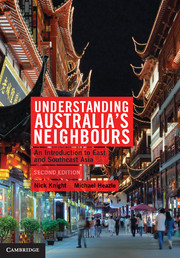Book contents
- Frontmatter
- Contents
- List of Maps
- Acronyms and abbreviations
- Acknowledgments
- Maps
- Introduction
- 1 The idea of ‘Asia’
- 2 Tradition and modernity in East and Southeast Asia
- 3 Tradition and modernity in East and Southeast Asia
- 4 Colonialism in East and Southeast Asia
- 5 Nationalism and revolution in East and Southeast Asia
- 6 Nations and nation-building in East and Southeast Asia
- 7 International politics and East and Southeast Asia
- 8 Economic growth in East and Southeast Asia
- 9 Democracy, human rights and development
- 10 Globalisation and East and Southeast Asia
- 11 China–Japan relations and US power in the twenty-first century
- 12 Australia in Asia, ‘Asia’ in Australia
- Bibliography
- Index
- References
11 - China–Japan relations and US power in the twenty-first century
Published online by Cambridge University Press: 05 June 2012
- Frontmatter
- Contents
- List of Maps
- Acronyms and abbreviations
- Acknowledgments
- Maps
- Introduction
- 1 The idea of ‘Asia’
- 2 Tradition and modernity in East and Southeast Asia
- 3 Tradition and modernity in East and Southeast Asia
- 4 Colonialism in East and Southeast Asia
- 5 Nationalism and revolution in East and Southeast Asia
- 6 Nations and nation-building in East and Southeast Asia
- 7 International politics and East and Southeast Asia
- 8 Economic growth in East and Southeast Asia
- 9 Democracy, human rights and development
- 10 Globalisation and East and Southeast Asia
- 11 China–Japan relations and US power in the twenty-first century
- 12 Australia in Asia, ‘Asia’ in Australia
- Bibliography
- Index
- References
Summary
AS WE HAVE OBSERVED in earlier chapters, ideas about East and Southeast Asia's modern history and development have been shaped by a variety of international forces ranging from colonial occupation and the Cold War to the economic, cultural, and political impact of globalisation. But, as also has been noted, the forces that shape our perspectives on the region's history should not only be understood in terms of Western influence, since the identities, values, and aspirations of the various societies and peoples of East and Southeast Asia have also played a major role in shaping their current circumstances and possible future paths, sometimes in ways that have generated influence and change far beyond their own region. One important example of this is Japan's rapid modernisation and rise as a regional power during the late eighteenth and early twentieth centuries, which later led to Japan becoming a colonial power in its own right and finally suffering defeat and occupation by the US and its allies in 1945. By 1968, however, Japan had established itself as the world's second largest economy, and, therefore, also a major actor in world affairs. Another is China's steady decline as the region's traditional centre of political and economic influence, which, unlike Japan, failed to modernise in response to growing European interest and power in Asia, followed by its post-war ascendancy to again become a major influence on regional affairs.
Both China and Japan have played central roles in East and Southeast Asia's history, and their contemporary influence is, perhaps more than ever, a major driver of economic and political developments throughout the region and beyond. However, China's rapid modernisation over the last three decades has resulted in two major indigenous powers co-existing in East Asia for the first time, creating a situation that has presented both opportunities and problems. In terms of trade and economic relations, Sino–Japanese relations appear to be at an all-time high. China has replaced the US as Japan's largest trading partner (Japan–China trade had already outpaced Japan's trade with the US in the January–June period of 2004), with total trade between Japan and the People's Republic of China (PRC), including Hong Kong, comprising 23.4 per cent of Japan's total trade in 2009.
- Type
- Chapter
- Information
- Understanding Australia's NeighboursAn Introduction to East and Southeast Asia, pp. 199 - 219Publisher: Cambridge University PressPrint publication year: 2011



